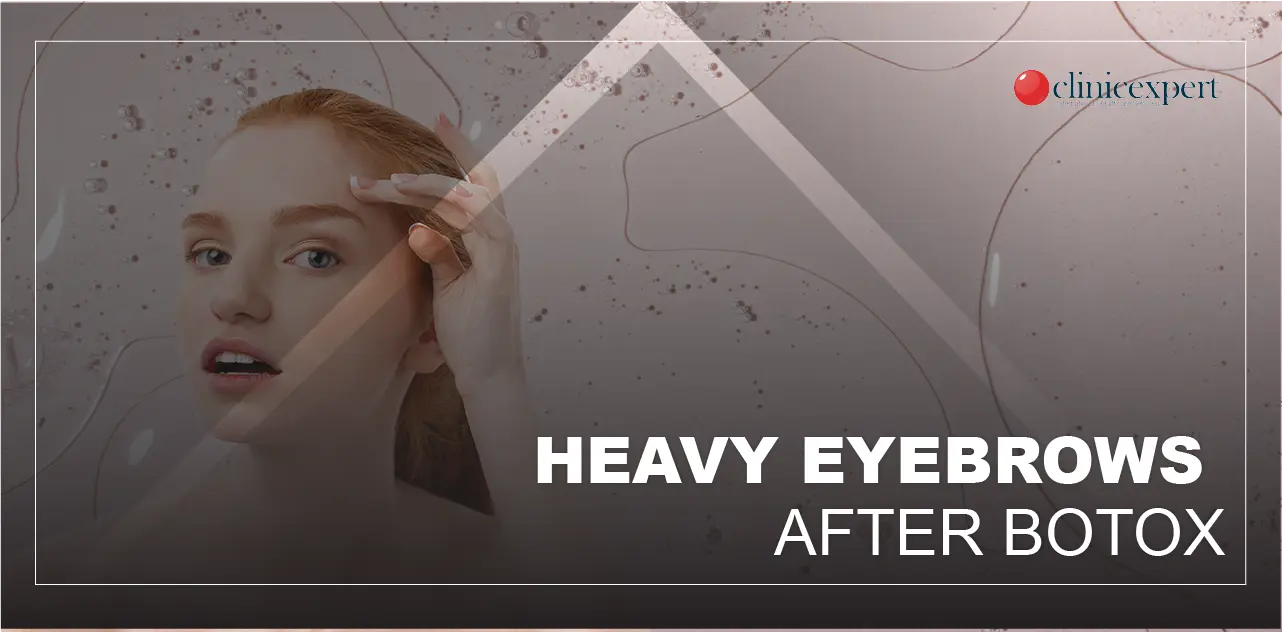Botox, a neurotoxin derived from Clostridium botulinum, works by temporarily paralyzing muscles. Specifically, it’s precisely injected into certain facial muscles responsible for wrinkles, thereby effectively relaxing them and smoothing the skin’s surface. Primarily, Botox is used to address forehead lines, crow’s feet, and frown lines. Consequently, Botox can offer dramatic improvements in one’s appearance, significantly enhancing confidence and satisfaction with one’s look.
How to Correct Heavy Forehead after Botox?
In the realm of cosmetic treatments, Botox stands out as a widely accepted solution for smoothing wrinkles and fine lines. It provides users with a fountain of youth in just a few minutes.
However, despite its popularity and overall high satisfaction rates, some people experience unexpected side effects after treatment, such as heavy eyebrows. So what can you do to get rid of it?
Heavy Eyebrows after Botox: Why Does It Occur?
Heavy eyebrows or a “dropped” eyebrow effect post-Botox can occur, although it’s relatively rare. This phenomenon typically results from the toxin affecting muscles around the eyebrows and forehead in ways not intended by the practitioner. Instead of lifting and smoothing, the muscles may relax too much, causing the eyebrows to feel heavier and potentially altering facial expressions.
Causes and Risk Factors
Several factors can contribute to the risk of developing heavy eyebrows after Botox, including:
Overcorrection: Excessive amounts of Botox injected into the forehead region can lead to an imbalance, causing the brows to droop.
Injection Placement: If Botox is injected too close to the eyebrow or into the wrong muscle, it can lead to unintended relaxation of the brow-lifting muscles.
Individual Anatomy: Variations in facial muscle strength and skin elasticity can influence how one responds to Botox, with some individuals more prone to this side effect than others.
How to Prevent It?
One of the most critical steps to avoid undesirable results, such as heavy eyebrows, is to choose an experienced and qualified practitioner of medical aesthetics. Look for practitioners with extensive knowledge of facial anatomy and a proven track record of achieving natural-looking results.
Personalized Treatment Plans
A personalized approach to Botox injections, considering your unique facial features and muscle strength, can significantly reduce the risk of complications. Discuss your concerns and desired outcomes with your practitioner to ensure the treatment plan aligns with your goals.
Post-Treatment Care
Following your practitioner’s aftercare instructions is essential for optimal results. While specific advice may vary, general recommendations include avoiding rubbing or massaging the treated area, which could inadvertently spread the toxin to adjacent muscles.
Remedies for Heavy Eyebrows After Botox
If you experience heavy eyebrows following Botox treatment, several strategies may help mitigate the effect:
Time: As Botox effects are temporary, the toxin wears off over 3 to 4 months. The heaviness should gradually diminish.
Additional Treatments: In some cases, strategic additional Botox injections can help counteract the drooping effect by targeting compensatory muscles.
Consultation with Your Practitioner: If you’re concerned about the results of your treatment, it’s crucial to revisit your practitioner. They can assess your situation and recommend the most appropriate course of action.
Smooth Botox Journeys with ClinicExpert
Yes, heavy eyebrows can be an unexpected side effect of Botox. However, understanding the causes and prevention strategies can significantly mitigate the risk. Should you experience this issue, remember that the effects are temporary and often correctable with professional guidance. By choosing a qualified practitioner from ClinicExpert and following tailored advice, you can enjoy the rejuvenating benefits of Botox while minimizing the likelihood of unwanted outcomes.

